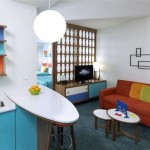Academic Interior Design: A Holistic Approach to Creating Learning Environments
Academic interior design is a specialized field that focuses on the creation of functional and inspiring learning spaces. It goes beyond mere aesthetics, considering the intricate interplay between physical environment and learning outcomes. Through careful planning and implementation, academic interior designers strive to enhance student engagement, foster collaboration, promote well-being, and ultimately, improve the overall learning experience. This article explores key aspects of academic interior design, emphasizing the importance of a holistic approach to creating successful learning environments.
The Importance of Functionality and Ergonomics
One of the fundamental principles of academic interior design is functionality. This encompasses creating spaces that are well-suited to the specific activities that will take place within them. For example, classrooms should be designed for active learning, with flexible seating arrangements, ample whiteboards, and easy access to technology. Libraries, on the other hand, require spaces that promote concentration and quiet study, with comfortable seating, adequate lighting, and noise-reducing elements. Ergonomics plays a crucial role in ensuring student comfort and well-being. This includes designing furniture, lighting, and technology that supports proper posture, reduces strain, and promotes healthy movement. Careful attention to these details can prevent fatigue, improve concentration, and enhance overall student performance.
Creating Inspiring and Engaging Atmospheres
Beyond functionality, academic interior design aims to create spaces that inspire and engage students. This involves incorporating elements that stimulate creativity, foster collaboration, and promote a sense of belonging. For instance, the use of vibrant colors, natural light, and stimulating artwork can create a positive and energetic atmosphere. Open and flexible learning spaces encourage interaction and teamwork, while designated areas for individual study provide quiet and focused environments. Architectural elements, such as curved walls, exposed beams, or unique lighting fixtures, can add character and intrigue, making the learning environment more stimulating and memorable.
Technology Integration: Enhancing Learning and Collaboration
Technology plays a vital role in modern education, and academic interior design incorporates it effectively. Designers must consider the seamless integration of technology into the learning environment, ensuring easy access, adequate power sources, and appropriate connectivity. This includes providing comfortable and functional spaces for laptop use, interactive whiteboards, and multimedia presentations. The incorporation of technology needs to be user-friendly and promote collaboration, allowing students to engage with content in new and innovative ways. By thoughtfully integrating technology, academic interior designers can create dynamic and interactive learning environments that prepare students for the digital age.
Sustainability and Environmental Considerations
Sustainable design principles are increasingly important in academic interior design. This involves using eco-friendly materials, incorporating energy-efficient systems, and prioritizing natural light and ventilation. Sustainable practices not only reduce environmental impact but also contribute to a healthier and more comfortable learning environment. For example, using locally sourced materials, recycled furniture, and energy-saving lighting fixtures can minimize environmental footprint while enhancing the aesthetics of the space. By prioritizing sustainable practices, academic interior designers can create spaces that are environmentally responsible and contribute to a more sustainable future for education.
The Importance of Inclusivity and Accessibility
Inclusivity and accessibility are paramount in academic interior design. Every student deserves access to a welcoming and supportive learning environment, regardless of their abilities or needs. This includes creating spaces that are accessible to individuals with disabilities, considering diverse learning styles, and promoting a sense of belonging for all students. Designers must incorporate universal design principles, such as ramps, accessible restrooms, and adjustable workspaces. Furthermore, they must consider the needs of students with visual, auditory, or cognitive impairments, providing appropriate accommodations and assistive technologies.
Collaboration and Professional Expertise
Effective academic interior design often involves a collaborative approach. Designers work closely with educators, students, and other stakeholders to ensure that the final design meets the specific needs and goals of the academic community. This collaborative process allows for open dialogue, feedback, and the incorporation of diverse perspectives. Academic interior designers bring a unique blend of design skills, educational knowledge, and an understanding of human behavior. They utilize research-informed design principles, drawing upon the latest findings in educational psychology, ergonomics, and sustainability to create spaces that optimize learning and well-being. By integrating the insights and expertise of various stakeholders, academic interior designers can create truly impactful and successful learning environments.

10 Best Interior Design Schools In The Us Decorilla

Interior Architecture Landscape And Master Of Arts Art Design Aalto University

8 School Interior Design Trends And Ideas For 2024 Rap Interiors

School Of Thought Interior Design For Modern Day Learning Outline

8 Simply Amazing University Building Designs

Interior Architecture And Design Ba Hons 2025 26 Entry Birmingham City University

Interior Design Program

Interior Design Woodbury University

Bachelor Of Arts In Interior Design Milan Ied

10 Best Interior Design Schools In The Us Decorilla








